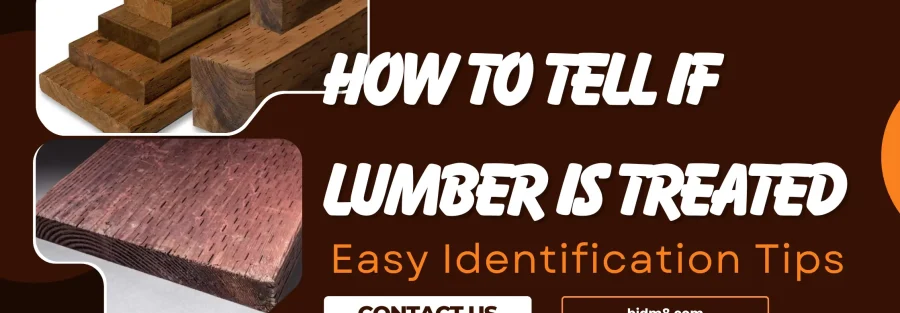How to Tell if Lumber is Treated: A Comprehensive Guide for DIY Enthusiasts and Professionals
Identifying whether lumber is treated is crucial for anyone working with wood, whether you’re a professional contractor, a DIY enthusiast, or a homeowner planning a construction project. Understanding how to tell if lumber is treated can help you make informed decisions about material selection, safety, and application. Wood treatment is a sophisticated process that transforms ordinary lumber into a resilient material capable of withstanding challenging environmental conditions.

Why Lumber Treatment Matters
Lumber treatment is a critical process that extends the wood’s durability and resistance to environmental challenges. Chemical treatments create a protective barrier that shields wood from various destructive elements, essentially giving it a second life beyond its natural state.
Environmental Protection Breakdown
| Threat | Untreated Wood | Treated Lumber |
|---|---|---|
| Moisture Damage | Rapid Deterioration | Highly Resistant |
| Insect Infestation | Vulnerable | Significantly Protected |
| Fungal Growth | Quick Decay | Substantially Inhibited |
| UV Exposure | Rapid Degradation | Enhanced Durability |
Treated lumber is specifically designed to withstand multiple environmental challenges. The chemical treatment process penetrates deep into the wood’s cellular structure, creating a robust defense mechanism that traditional untreated lumber simply cannot match.
7 Foolproof Methods to Identify Treated Lumber
1. Examine Lumber Stamps and Tags
The most straightforward way to determine lumber treatment is by carefully examining the wood’s surface. Lumber stamps are like a secret code that reveals the wood’s entire treatment history. These markings are not just random scratches, but a professional communication system used across the woodworking industry.
When inspecting lumber stamps, you’ll encounter a variety of abbreviations that might seem cryptic at first. These codes are actually precise scientific notations that describe the exact chemical treatment used. Professional woodworkers and contractors learn to read these stamps like a second language.
Common Treatment Abbreviations:
| Abbreviation | Treatment Type | Primary Use |
|---|---|---|
| ACQ | Alkaline Copper Quaternary | Exterior Construction |
| CA | Copper Azole | Ground-Contact Projects |
| SBX | Sodium Borate | Indoor Wood Protection |
| CCA | Chromated Copper Arsenate | Historical Treatments |
2. Visual Color Inspection
Treated lumber often displays distinctive color characteristics that set it apart from untreated wood. Think of these color variations as the wood’s chemical fingerprint. The treatment process doesn’t just protect the wood; it fundamentally alters its appearance.
Color transformations occur due to the chemical reactions between wood fibers and preservative compounds. These changes aren’t superficial – they penetrate deep into the wood’s structure. Professional woodworkers can often identify treated lumber with just a quick glance, recognizing the telltale signs of chemical intervention.
3. The Smell Test
Chemical treatments leave behind a unique olfactory signature that distinguishes treated lumber from its untreated counterparts. This isn’t just a subtle difference – it’s a dramatic sensory experience that immediately signals chemical treatment.
The smell of treated lumber is complex and unmistakable. It’s a mixture of chemical preservatives that create a distinctive odor profile. While some might find it unpleasant, this smell is actually a testament to the wood’s enhanced durability and protective capabilities.
4. Incision Marks
Pressure-treated lumber features intentional incision marks that serve a crucial functional purpose. These aren’t random cuts or manufacturing defects – they’re carefully engineered channels designed to enhance chemical penetration.
The precision of these incisions is remarkable. Measuring between 1/2 to 3/4 inch long, they are strategically placed to ensure maximum treatment effectiveness. Imagine these marks as microscopic highways that allow protective chemicals to travel deep into the wood’s core.
5. Size and Texture Variations
Treated lumber exhibits subtle yet significant physical differences compared to untreated wood. These variations are more than cosmetic – they represent the profound chemical changes occurring within the wood’s structure.
The absorption of chemical preservatives causes slight dimensional changes. Wood becomes slightly more robust, with a unique texture that speaks to its enhanced durability. These changes are a testament to the sophisticated treatment processes used in modern woodworking.
6. Request a Fact Sheet
Documentation provides the most definitive confirmation of lumber treatment. Fact sheets are more than just pieces of paper – they’re comprehensive records that tell the complete story of the wood’s chemical journey.
Environmental Protection Agency (EPA) regulations mandate detailed reporting for treated lumber. These documents offer transparency, providing critical information about chemical compositions, safety protocols, and recommended usage guidelines.
7. Chemical Testing Kits
For scenarios requiring absolute certainty, specialized chemical testing kits offer a scientific approach to lumber identification. These aren’t just simple diagnostic tools – they’re precision instruments that can reveal the most subtle chemical traces.
Most testing kits focus on detecting specific chemical compounds, providing a forensic-level analysis of wood treatment. While primarily used for older lumber or critical applications, they represent the pinnacle of wood identification technology.
Conclusion
How to tell if lumber is treated is an essential skill that combines observation, knowledge, and sometimes scientific analysis. By understanding these multiple identification methods, you transform from a passive wood user to an informed material expert.
Frequently Asked Questions
Can treated lumber be used for all projects?
Not necessarily. Different treatments suit different environments. Always match the lumber’s chemical protection to your specific project requirements.
How long do treatment chemicals remain effective?
Treatment longevity varies. Exterior applications typically maintain protection for 10-20 years, while indoor treatments can last even longer under optimal conditions.
Are there environmental considerations with treated lumber?
Modern treatments are increasingly eco-friendly, but always consult specific product guidelines and follow proper handling and disposal recommendations.

